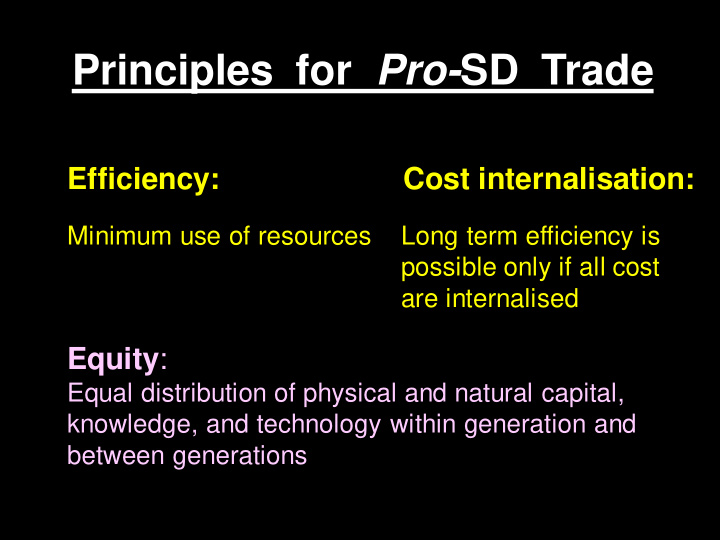



Principles for Pro- SD Trade Efficiency: Cost internalisation: Minimum use of resources Long term efficiency is possible only if all cost are internalised Equity : Equal distribution of physical and natural capital, knowledge, and technology within generation and between generations 1
Principles of pro-sustainable development trade …..continued Environmental integrity : It is recognition of the impact of human activities on ecosystem, carrying capacity, and bio- diversity. Subsidiarity : Decision should be taken as close as possible to the affected public. Subsidiarities considered are diversity, tolerance, and decentralisation. 2
Principles of pro-sustainable development trade …..continued International co-operation : Effort should be aimed at addressing the interests of economy, development, and environment Science and technology : It provides basis while Adaptive approach is valuable before confirmation by science and technology Openness : Openness and accountability are the corner - stones of environment friendly sustainable trade 3
Want to Buy a New Technology ? ? What steps should be followed when decided to buy new technology ? a) evaluate the alternative routes b) avoid process schemes involving toxic and reactive chemicals c) develop the “greener process” and follow a “greener practice” 4
Want to buy a new technology? …..continued Small checklist for ‘greener process’ and ‘greener practice’: (a) select continuous reactor for even small volume products (b) semi-batch operation is better than batch operation (c) select a low risk and low polluting mode of operation (d) prepare hazardous reactants at site (e) store hazardous and toxic gases at low pressure and low temp 5
Want to buy a new technology? …..continued Is imported technology better? a) “Proven technology” is usually obsolete b) These technologies “come” with their EOP Installation “New technologies” are usually greener There is no shortcut to the environmentally sound and resources conserving technology The best REMEDY is: “Be Self Reliant !” 6
S&T as the Remedy There are two prongs of S&T! [1] Develop right kind of “appropriate” technologies! Who does that? Who funds that? Who teams? [2] Try those “appropriate” alternatives in the field! Who does that? Who funds that? Who teams? This presentation deals with the second prong. The real problem is regarding identification and stakeholders . 7
S&T as Remedy …..continued Stakeholders in capacity building are: Management entities of firms and industrial estates, Regulators, Policy makers, Financial institutions, General public Actions of stakeholders: a) awareness campaigns on cleaner production options (CPOs) b) demonstration projects and training augmented by update on relevant information 8
S&T as Remedy …..continued It should be recognised that several stakeholders in the community have equally significant roles to play in translating intentions of environmental protection to a reality Routes employed by the different stakeholders can be diverse Firms should have good housekeeping, better process management, comprehensive treatment, and safe disposal 9
S&T as Remedy …..continued Process of creating awareness and building capacities of the stakeholders with the principle aim of improving preparedness and participate in action that leads to sustainable development Finance and reliability of technologies are the pre-requisite for carrying out capacity building The action for enabling quantitative and qualitative changes should be supported by adequate information and capacity building of the diverse stakeholders 10
S&T as Remedy …..continued Financial institutions, bilateral and multilateral agencies have an important role to play in enabling access to cleaner technologies and technology adaptations Actions to achieve S ustainable Development: a) initiatives in information support and capacity building b) learning and action, mutually strengthen each other and are expressed as voluntary initiatives or guided participation 11
Capacity Building: Integral Part of Corporate Action Corporate actions : a) corporate leaders in Indonesia, Malaysia, and Thailand emerged to provide leadership in business to avoid environmental mistakes b) a initiative by communities in collaboration with National Human Rights Commission and the Center for Science and Environment (CSE) could stop a paper mill dumping its effluents into Bhatinda Canal and also to establish a chemical recovery plant for treating its black liquor 12
Recommend
More recommend